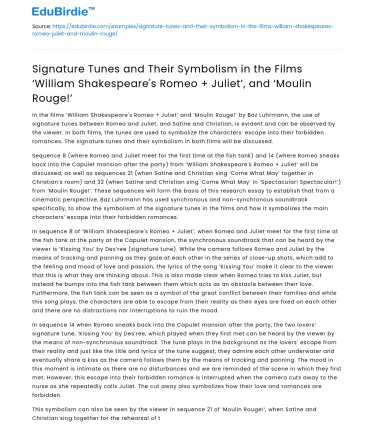In the films ‘William Shakespeare's Romeo + Juliet’ and ‘Moulin Rouge!’ by Baz Luhrmann, the use of signature tunes between Romeo and Juliet, and Satine and Christian, is evident and can be observed by the viewer. In both films, the tunes are used to symbolize the characters’ escape into their forbidden romances. The signature tunes and their symbolism in both films will be discussed.
Sequence 8 (where Romeo and Juliet meet for the first time at the fish tank) and 14 (where Romeo sneaks back into the Capulet mansion after the party) from ‘William Shakespeare's Romeo + Juliet’ will be discussed, as well as sequences 21 (when Satine and Christian sing ‘Come What May’ together in Christian’s room) and 32 (when Satine and Christian sing ‘Come What May’ in ‘Spectacular! Spectacular!’) from ‘Moulin Rouge!’. These sequences will form the basis of this research essay to establish that from a cinematic perspective, Baz Luhrmann has used synchronous and non-synchronous soundtrack specifically, to show the symbolism of the signature tunes in the films and how it symbolizes the main characters’ escape into their forbidden romances.
Save your time!
We can take care of your essay
- Proper editing and formatting
- Free revision, title page, and bibliography
- Flexible prices and money-back guarantee
In sequence 8 of ‘William Shakespeare's Romeo + Juliet’, when Romeo and Juliet meet for the first time at the fish tank at the party at the Capulet mansion, the synchronous soundtrack that can be heard by the viewer is ‘Kissing You’ by Des’ree (signature tune). While the camera follows Romeo and Juliet by the means of tracking and panning as they gaze at each other in the series of close-up shots, which add to the feeling and mood of love and passion, the lyrics of the song ‘Kissing You’ make it clear to the viewer that this is what they are thinking about. This is also made clear when Romeo tries to kiss Juliet, but instead he bumps into the fish tank between them which acts as an obstacle between their love. Furthermore, the fish tank can be seen as a symbol of the great conflict between their families and while this song plays, the characters are able to escape from their reality as their eyes are fixed on each other and there are no distractions nor interruptions to ruin the mood.
In sequence 14 when Romeo sneaks back into the Capulet mansion after the party, the two lovers’ signature tune, ‘Kissing You’ by Des’ree, which played when they first met can be heard by the viewer by the means of non-synchronous soundtrack. The tune plays in the background as the lovers’ escape from their reality and just like the title and lyrics of the tune suggest, they admire each other underwater and eventually share a kiss as the camera follows them by the means of tracking and panning. The mood in this moment is intimate as there are no disturbances and we are reminded of the scene in which they first met. However, this escape into their forbidden romance is interrupted when the camera cuts away to the nurse as she repeatedly calls Juliet. The cut away also symbolizes how their love and romances are forbidden.
This symbolism can also be seen by the viewer in sequence 21 of ‘Moulin Rouge!’, when Satine and Christian sing together for the rehearsal of the performance ‘Spectacular! Spectacular!’. The synchronous soundtrack of the pair singing ‘Come What May’ (signature tune) can be heard by the viewer as the camera zooms into the pair singing and then zooms out featuring a series of cut away shots of the private moments they shared together. These private moments accompanied by the tune symbolize the pair’s escape into their forbidden secret love affair. The title of the tune also suggests that no matter how bad things become they will always love each other.
In sequence 32 when Satine and Christian sing ‘Come What May’ in the final of ‘Spectacular! Spectacular!’, Christian plays the part of Satine’s character’s lover and as he walks off stage, we see a close up of Satine as she starts singing ‘Come What May’ to Christian. To the audience watching the performance in the film it seems as if the song is a part of the performance but to the viewer it is evident that it is the pair’s signature tune and it has meaning for their forbidden relationship. The song in the performance gives them a chance to escape from their reality and obstacles that they face and it is their reminder that they love each other no matter what comes their way.
It is clear that from a cinematic perspective, Baz Luhrmann has used synchronous and non-synchronous soundtrack specifically, to show the symbolism of the signature tunes in the films ‘William Shakespeare's Romeo + Juliet’, and ‘Moulin Rouge!’, and how they symbolize the main characters’ escape into their forbidden romances.






 Stuck on your essay?
Stuck on your essay?

